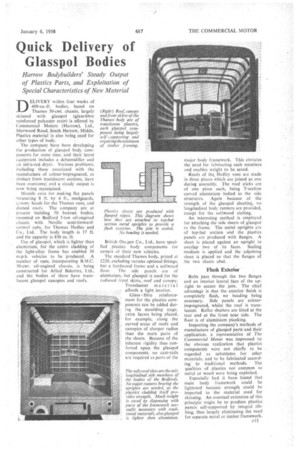Quick Delivery of Glasspol Bodies
Page 55

If you've noticed an error in this article please click here to report it so we can fix it.
Harrow Bodybuilders' Steady Output of Plastics Parts, and Exploitation of Special Characteristics of New Material
DELIVERY within four weeks of 400-cu.-ft. bodies, based on Thames 30-cwt. chassis, largely skinned with glasspol (glass-fibre reinforced polyester resin) is offered by Commercial Motors (Harrow), Ltd., Sherwood Road, South Harrow, Middx. Plastics material is also being used for other types of body.
The company have been developing the production of glasspol body components for some time, and their latest. equipment includes a dehumidifier and an infra-red dryer. Various problems, including those associated with the manufacture of colour-impregnated, as distinct from translucent sections, have been overcome; and a steady output is now being maintained.
Moulds exist for making flat panels measuring 8 ft. by 4 ft., mudguards, canopy heads for the Thames vans, and domed roofs. The company are at present building 50 boxvan bodies, mounted on Bedford 5-ton oil-engined chassis with Neville semi-forwardcontrol cabs, for Thomas HedIey and Co., Ltd. The bodY length is 17 ft. and the capacity. is 830 cu. ft.
Use of glasspol, which is lighter than aluminium, for the entire cladding of the light-alloy frame has enabled 30 m.p.h. vehicles to be produced. A number of vans, incorporating B.M.C. 30-cwt oil-engined chassis, is being constructed for .Allied Bakeries, Ltd., and the bodies of these have translucent glasspol canopies and roofs. British Oxygen Co., Ltd., have specified plastics body components for certain of their new vehicles.
The standard Thames body, priced at £220, excluding various optional fittings, has a hardwood frame and a softwood floor. The side panels are of aluminium, but glasspol is used for the radiused front skirts, roof and canopy. Translucent material affords a light interior.
Glass fibre reinforcement for the plastics components can be added during the moulding stage, extra layers being placed, for example, along the curved areas of roofs and canopies of sharper radius than the main parts of the sheets. Because of the inherent rigidity thus conferred upon the glasspol components. no cant-rails are required as parts of the
major body framework. This obviates the need for fabricating such members and enables weight to be saved.
Roofs of the_ Hedley vans are made in three pieces which are joined as one during assembly. The roof sticks are of one piece each, being T-section curved aluminium bolted to the side structures. Again because of the strength of the glasspol sheeting, no longitudinal body runners are provided, except for the softwood slatting.
An interesting method is employed for attaching the side sheets of glasspol to the frame. . The metal uprights are of top-hat section and the plastics panels are produced with flanges. A sheet is placed against an upright to overlap two of its faces. Sealing medium is applied and the adjoining sheet is placed so that the flanges of the two sheets abut.
Flush Exterior
Bolts pass through the two flanges and art interior lateral face of the upright to secure the join. The chief advantage is that the exterior finish is completely flush, no beading being necessary. Side panels are colourimpregnated, whilst the roof is translucent. Roller shutters are fitted at the rear and at the front near side. The floor is of aluminium planking:
Inspecting the company's methods of manufacture of glasspol parts-and their application, a representative of The Commercial Motor was impressed by the obvious realization that plastics components were not chiefly to be regarded as substitutes for other materials, and to be fabricated according to traditional methods. The qualities of plastics not common to metal or 'wood were being exploited.
Especially had it been found that main body framework could be lightened because strength could be imparted to the material used for skinning. An eventual extension of this principle might be to produce plastics panels self-supported by integral ribbing, thus largely eliminating the need for separate metal or timber framework.
















































































































